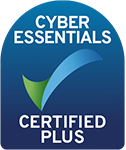In our series of ‘how to’ videos we include tips on using Mimecast cloud cybersecurity. This time, we look at how to access and work with Mimecast ‘on hold’ messages via the Mimecast website portal or Outlook app.
Mimecast provides a whole range of tools for email, data and web to help prevent cyber threats affecting your business. Here we focus on email messages.
Watch the video or read on to learn how to get the best out of your Mimecast ‘on hold’ messages system.
Mimecast on Outlook
1. On your Outlook you’ll have the Home tab options and you will see the Mimecast add-in.
2. Click on that and you’ll see the ‘on hold messages’ button.
3. Here, you will be able to see any ‘on hold’ messages that are in your personal queue, or in your moderated queue. A personal queue is any email sent to your inbox and the moderated queue is for any mailboxes that you look after such as ‘info at’ or ‘sales at’, where you might be an overseer. Note that this would need to be set up beforehand, so just for this video we will be looking at the personal ‘on hold’ messages.
4. Select ‘personal’ and ‘hold’ and you will get a pop-up screen that will show you any messages that are on hold. You can click on them and have a quick read – for your security Mimecast doesn’t show any images but you can opt to click to display them as well. It also tells you why the messages is being held – for example, it could be the Spam Signature Policy.
5. Using that example, if you see that it isn’t a spam message, along the top bar there is a ‘release’ button. You can click ‘release’ and permit the address. That will add the single address into your permit list. This means that this account will never be blocked for spam again.
6. There is also the ‘release message and permit domain’ option. That will add the domain to your ‘allow’ list. Now this can be a very useful tool if you receive emails from, say, a customer or client and they often get blocked for spam. However, we don’t recommend adding anything such as Yahoo, Gmail or Outlook.com to this ‘allow’ list as then, all these emails will miss this important cybersecurity check.
7. Instead of releasing the email you can also ‘reject’ the email. This deletes it.
8. Or you can ‘reject message and block the address’, which is just for the one specific address that sent you the email (which is the most preferred option).
9. Or you can ‘reject message and block the domain’ as well. You are less likely to need this – remember, if you were to block someone such as@gmail.com or outlook or Yahoo then no one from that whole domain will be able to send you any emails at all!
10. You can also mark messages as spam and these can be sent off to Mimecast for analysis, so they can help prevent these in the future.
Mimecast personal portal
1. Log into Mimecast and enter your email address and password, as well as the multifactor authentication code if required.
2. On the next screen, you’ll see the Mimecast personal portal option.
3. Log into this option and you will see your inbox, where you have access to emails. On the left-hand side there are three dots, for the advanced option. Click into that to view your personal ‘on hold’ messages.
As with the Outlook instructions above, you can read emails, report as spam/phishing, or release the message, permit sender or domain – or reject the message sender or domain. You can also access the moderated ‘on hold’ as well if you do have access to any shared mailboxes.
So that’s it for working with your Mimecast ‘on hold’ messages.
We can help you with all kinds of cybersecurity issues, including Cyber Essentials, as well as other business IT support. If you have any questions, please feel free to contact us below.







